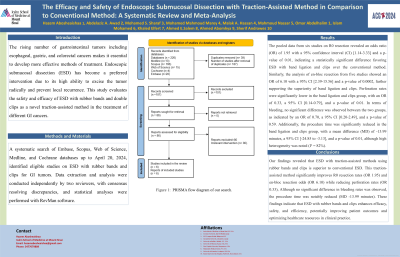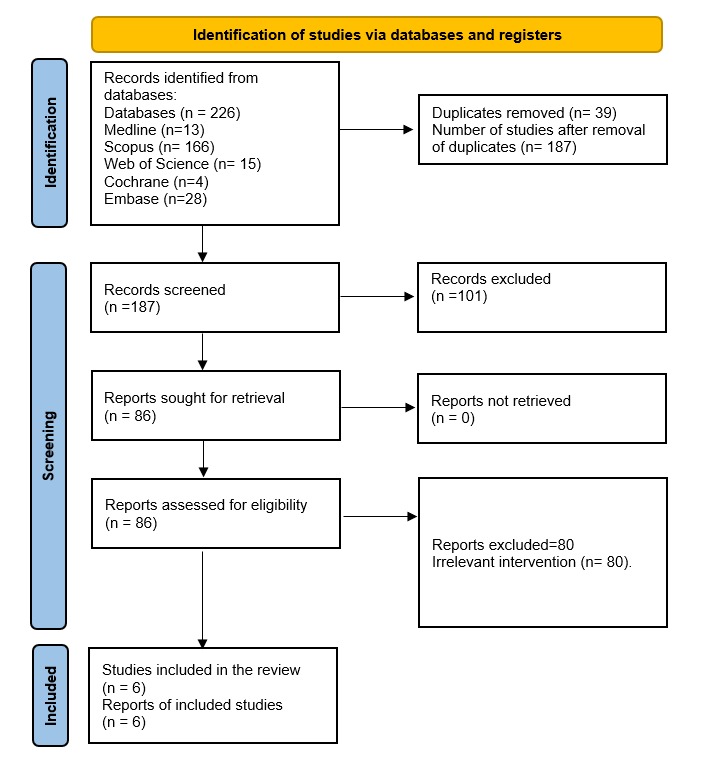Sunday Poster Session
Category: Interventional Endoscopy
P1063 - Efficacy and Safety of Endoscopic Submucosal Dissection With Traction-Assisted Method in Comparison to Conventional Method: A Systematic Review and Meta-Analysis
Sunday, October 27, 2024
3:30 PM - 7:00 PM ET
Location: Exhibit Hall E

Has Audio
.jpg)
Hazem Abosheaishaa, MD
Icahn School of Medicine at Mount Sinai
Queens, NY
Presenting Author(s)
Hazem Abosheaishaa, MD1, Abdelaziz A. Awad, 2, Mohamed S. Sharaf, MBBCh3, Mohamed Mahmoud. Marey, MBBCh4, Malak A. Hassan, 5, Mahmoud Nassar, MD, PhD, MSc, MPA6, Omar Abdelhalim, MD1, Islam Mohamed, MD7, Khaled Elfert, MD8, Ahmed E. Salem, MBBCh9, Ahmed Abomhya, MD10, Sherif Andrawes, MD11
1Icahn School of Medicine at Mount Sinai, Queens, NY; 2Al-Azhar University, Kafr Elsheikh, Kafr ash Shaykh, Egypt; 3NYU Langone Health, Ridgewood, NY; 4Alexandria Faculty of Medicine, Alexandria, Al Iskandariyah, Egypt; 5Alexandria University, Alexandria, Al Iskandariyah, Egypt; 6Jacobs School of Medicine and Biomedical Sciences, University at Buffalo, Buffalo, NY; 7University of Missouri, Kansas City, MO; 8West Virginia University, Morgantown, WV; 9Maimonides Medical Center, Brooklyn, NY; 10University of Kentucky, Lexington, KY; 11Staten Island University Hospital, Northwell Health, Staten Island, NY
Introduction: The rising number of gastrointestinal tumors including esophageal, gastric, and colorectal cancers makes it essential to develop more effective methods of treatment. Endoscopic submucosal dissection (ESD) has become a preferred intervention due to its high ability to excise the tumor radically and prevent local recurrence. This study evaluates the safety and efficacy of ESD with rubber bands and double clips as a novel traction-assisted method in the treatment of different GI cancers.
Methods: A systematic search of Embase, Scopus, Web of Science, Medline, and Cochrane databases up to April 20, 2024, identified eligible studies on ESD with rubber bands and clips for GI tumors. Data extraction and analysis were conducted independently by two reviewers, with consensus resolving discrepancies, and statistical analyses were performed with RevMan software.
Results: The pooled data from six studies on R0 resection revealed an odds ratio (OR) of 1.95 with a 95% confidence interval (CI) [1.14-3.33] and a p-value of 0.01, indicating a statistically significant difference favoring ESD with band ligation and clips over the conventional method. Similarly, the analysis of en-bloc resection from five studies showed an OR of 6.10 with a 95% CI [2.39-15.56] and a p-value of 0.0002, further supporting the superiority of band ligation and clips. Perforation rates were significantly lower in the band ligation and clips group, with an OR of 0.33, a 95% CI [0.14-0.79], and a p-value of 0.01. In terms of bleeding, no significant difference was observed between the two groups, as indicated by an OR of 0.70, a 95% CI [0.20-2.49], and a p-value of 0.59. Additionally, the procedure time was significantly reduced in the band ligation and clips group, with a mean difference (MD) of -13.99 minutes, a 95% CI [-24.85 to -3.13], and a p-value of 0.01, although high heterogeneity was noted (I² = 82%).
Discussion: Our findings revealed that ESD with traction-assisted methods using rubber bands and clips is superior to conventional ESD. This traction-assisted method significantly improves R0 resection rates (OR 1.95) and en-bloc resection odds (OR 6.10) while reducing perforation rates (OR 0.33), Although no significant difference in bleeding rates was observed, the procedure time was notably reduced (MD -13.99 minutes). These findings indicate that ESD with rubber bands and clips enhances efficacy, safety, and efficiency, potentially improving patient outcomes and optimizing healthcare resources in clinical practice.

Disclosures:
Hazem Abosheaishaa, MD1, Abdelaziz A. Awad, 2, Mohamed S. Sharaf, MBBCh3, Mohamed Mahmoud. Marey, MBBCh4, Malak A. Hassan, 5, Mahmoud Nassar, MD, PhD, MSc, MPA6, Omar Abdelhalim, MD1, Islam Mohamed, MD7, Khaled Elfert, MD8, Ahmed E. Salem, MBBCh9, Ahmed Abomhya, MD10, Sherif Andrawes, MD11. P1063 - Efficacy and Safety of Endoscopic Submucosal Dissection With Traction-Assisted Method in Comparison to Conventional Method: A Systematic Review and Meta-Analysis, ACG 2024 Annual Scientific Meeting Abstracts. Philadelphia, PA: American College of Gastroenterology.
1Icahn School of Medicine at Mount Sinai, Queens, NY; 2Al-Azhar University, Kafr Elsheikh, Kafr ash Shaykh, Egypt; 3NYU Langone Health, Ridgewood, NY; 4Alexandria Faculty of Medicine, Alexandria, Al Iskandariyah, Egypt; 5Alexandria University, Alexandria, Al Iskandariyah, Egypt; 6Jacobs School of Medicine and Biomedical Sciences, University at Buffalo, Buffalo, NY; 7University of Missouri, Kansas City, MO; 8West Virginia University, Morgantown, WV; 9Maimonides Medical Center, Brooklyn, NY; 10University of Kentucky, Lexington, KY; 11Staten Island University Hospital, Northwell Health, Staten Island, NY
Introduction: The rising number of gastrointestinal tumors including esophageal, gastric, and colorectal cancers makes it essential to develop more effective methods of treatment. Endoscopic submucosal dissection (ESD) has become a preferred intervention due to its high ability to excise the tumor radically and prevent local recurrence. This study evaluates the safety and efficacy of ESD with rubber bands and double clips as a novel traction-assisted method in the treatment of different GI cancers.
Methods: A systematic search of Embase, Scopus, Web of Science, Medline, and Cochrane databases up to April 20, 2024, identified eligible studies on ESD with rubber bands and clips for GI tumors. Data extraction and analysis were conducted independently by two reviewers, with consensus resolving discrepancies, and statistical analyses were performed with RevMan software.
Results: The pooled data from six studies on R0 resection revealed an odds ratio (OR) of 1.95 with a 95% confidence interval (CI) [1.14-3.33] and a p-value of 0.01, indicating a statistically significant difference favoring ESD with band ligation and clips over the conventional method. Similarly, the analysis of en-bloc resection from five studies showed an OR of 6.10 with a 95% CI [2.39-15.56] and a p-value of 0.0002, further supporting the superiority of band ligation and clips. Perforation rates were significantly lower in the band ligation and clips group, with an OR of 0.33, a 95% CI [0.14-0.79], and a p-value of 0.01. In terms of bleeding, no significant difference was observed between the two groups, as indicated by an OR of 0.70, a 95% CI [0.20-2.49], and a p-value of 0.59. Additionally, the procedure time was significantly reduced in the band ligation and clips group, with a mean difference (MD) of -13.99 minutes, a 95% CI [-24.85 to -3.13], and a p-value of 0.01, although high heterogeneity was noted (I² = 82%).
Discussion: Our findings revealed that ESD with traction-assisted methods using rubber bands and clips is superior to conventional ESD. This traction-assisted method significantly improves R0 resection rates (OR 1.95) and en-bloc resection odds (OR 6.10) while reducing perforation rates (OR 0.33), Although no significant difference in bleeding rates was observed, the procedure time was notably reduced (MD -13.99 minutes). These findings indicate that ESD with rubber bands and clips enhances efficacy, safety, and efficiency, potentially improving patient outcomes and optimizing healthcare resources in clinical practice.

Figure: PRISMA flow chart for search Strategy
Disclosures:
Hazem Abosheaishaa indicated no relevant financial relationships.
Abdelaziz Awad indicated no relevant financial relationships.
Mohamed Sharaf indicated no relevant financial relationships.
Mohamed Marey indicated no relevant financial relationships.
Malak Hassan indicated no relevant financial relationships.
Mahmoud Nassar indicated no relevant financial relationships.
Omar Abdelhalim indicated no relevant financial relationships.
Islam Mohamed indicated no relevant financial relationships.
Khaled Elfert indicated no relevant financial relationships.
Ahmed Salem indicated no relevant financial relationships.
Ahmed Abomhya indicated no relevant financial relationships.
Sherif Andrawes indicated no relevant financial relationships.
Hazem Abosheaishaa, MD1, Abdelaziz A. Awad, 2, Mohamed S. Sharaf, MBBCh3, Mohamed Mahmoud. Marey, MBBCh4, Malak A. Hassan, 5, Mahmoud Nassar, MD, PhD, MSc, MPA6, Omar Abdelhalim, MD1, Islam Mohamed, MD7, Khaled Elfert, MD8, Ahmed E. Salem, MBBCh9, Ahmed Abomhya, MD10, Sherif Andrawes, MD11. P1063 - Efficacy and Safety of Endoscopic Submucosal Dissection With Traction-Assisted Method in Comparison to Conventional Method: A Systematic Review and Meta-Analysis, ACG 2024 Annual Scientific Meeting Abstracts. Philadelphia, PA: American College of Gastroenterology.
